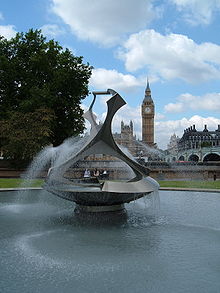Naum Gabo
| Naum Gabo | |
|---|---|

|
|
| Born |
Naum Neemia Pevsner 5 August 1890 Bryansk, Russian Empire |
| Died | 23 August 1977 (aged 87) Waterbury, Connecticut |
| Nationality | Russian |
| Known for | Sculpture, Kinetic art |
| Movement | Constructivism |
Naum Gabo, born Naum Neemia Pevsner (5 August [O.S. 24 July] 1890 – 23 August 1977) (Hebrew: נחום נחמיה פבזנר) was a prominent Russian sculptor in the Constructivism movement and a pioneer of Kinetic Art.
Gabo grew up in a Jewish family of six children in the provincial Russian town of Bryansk, where his father owned a factory. His older brother was fellow Constructivist artist Antoine Pevsner; Gabo changed his name to avoid confusion with him. Gabo was a fluent speaker and writer in German, French, and English in addition to his native Russian. His command of several languages contributed greatly to his mobility during his career. “As in thought, so in feeling, a vague communication is no communication at all," Gabo once remarked.
After school in Kursk, Gabo entered Munich University in 1910, first studying medicine, then the natural sciences, and attended art history lectures by Heinrich Wölfflin. In 1912 Gabo transferred to an engineering school in Munich where he discovered abstract art and met Wassily Kandinsky and in 1913-14 joined his brother Antoine (who by then was an established painter) in Paris. Gabo's engineering training was key to the development of his sculptural work that often used machined elements. During this time he won acclamations by many critics and awards like the $1000 Mr and Mrs Frank G. Logan Art Institute Prize at the annual Chicago and Vicinity exhibition of 1954.
After the outbreak of war, Gabo moved first to Copenhagen then Oslo with his older brother Alexei, making his first constructions under the name Naum Gabo in 1915. These earliest constructions originally in cardboard or wood were figurative such as the Head No.2 in the Tate collection. He moved back to Russia in 1917, to become involved in politics and art, spending five years in Moscow with his brother Antoine.
...
Wikipedia
